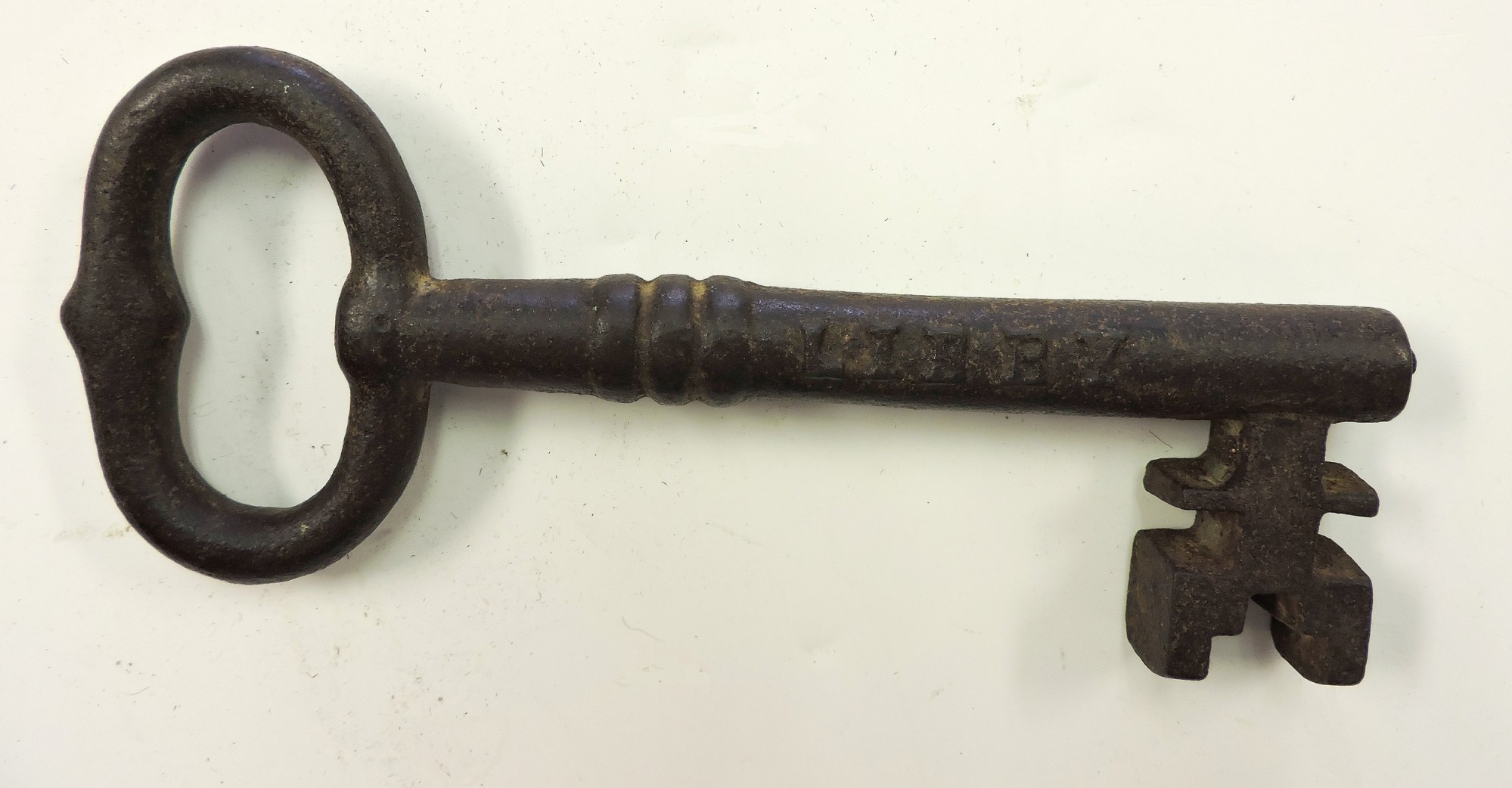site search
online catalog
LIBBY PRISON SOUVENIR KEY

$195.00 SOLD
Quantity Available: None
Item Code: 819-38
This iron souvenir key from Libby Prison was sold at the Chicago Fair. Some surface rust is present. Key measures 7 ¼” long x 3” wide at the handle. Sides of key are marked with, “LIBBY PRISON”.
Libby Prison was a Confederate prison at Richmond, Virginia, during the American Civil War. It gained an infamous reputation for the overcrowded and harsh conditions under which officer prisoners from the Union Army were kept. Prisoners suffered from disease, malnutrition and a high mortality rate. By 1863, one thousand prisoners were crowded into large open rooms on two floors, with open, barred windows leaving them exposed to weather and temperature extremes.
The prison was located in a three-story brick warehouse on two levels on Tobacco Row at the waterfront of the James River. Prior to use as a jail, the warehouse had been leased by Capt. Luther Libby and his son George W. Libby. They operated a ship's chandlery and grocery business.
The Confederate government started to use the facility as a hospital and prison in 1861, reserving it for Union officers in 1862 because of the influx of prisoners. It contained eight low-ceilinged rooms, each 103 by 42 feet. The second and third floors were used to house prisoners. Windows were barred and open to the elements, increasing the discomfort. Lack of sanitation and overcrowding caused diseases. From 700 prisoners in 1862, the facility had a total of 1,000 by 1863. Mortality rates were high in 1863 and 1864, aggravated by shortages of food and supplies. Because of the high death toll, Libby Prison is generally regarded as only second in notoriety to Andersonville Prison in Georgia.
In 1864, the Confederacy moved Union prisoners to Macon, Georgia. The Confederate Army then used the prison for military criminals.
After the occupation of Richmond in 1865, Union authorities used the prison for detention of former Confederate officers. They reportedly improved conditions over those for Union officers or prisoners of war on both sides generally during the war.
In 1880, the building was purchased by Southern Fertilizer Company. Nine years later, it was bought by Charles F. Gunther, a candymaker, disassembled, and moved to Chicago, Illinois. There it was rebuilt and renovated to serve as a war museum (1889-1895). After the museum failed to draw enough crowds, the building was dismantled and was sold in pieces as souvenirs.
“The building is of brick, with a front of near one hundred and forty feet, and one hundred feet deep. It is divided into nine rooms; the ceilings are low, and ventilation imperfect; the windows are barred, through which the windings of James River and the tents of Belle Isle may be seen.”
In April 1865, U.S. President Abraham Lincoln visited Richmond, Virginia and toured the city on foot. When he came across Libby Prison, a crowd of onlookers stated "We will tear it down", to which Lincoln replied, "No, leave it as a monument.
~~~~~~~~~~~~~~~~~~~~~~~~~~~~~~~~~~~
THIS ITEM, AS WITH ALL OTHER ITEMS AVAILABLE ON OUR WEB SITE,
MAY BE PURCHASED THROUGH OUR LAYAWAY PROGRAM.
FOR OUR POLICIES AND TERMS,
CLICK ON ‘CONTACT US’ AT THE TOP OF ANY PAGE ON THE SITE,
THEN ON ‘LAYAWAY POLICY’.
THANK YOU!
Inquire About LIBBY PRISON SOUVENIR KEY
For inquiries, please email us at [email protected]
Most Popular
Historical Firearms Stolen From The National Civil War Museum In Harrisburg, Pa »
Theft From Gravesite Of Gen. John Reynolds »
Cavalry Carbine Sling Swivel »
Fine Condition Brass Infantry Bugle Insignia »
featured item
CONFEDERATE GENERAL LUNSFORD LINDSAY LOMAX AS A WEST POINT CADET IN DAGUERREOTYPE BY ANSON CA. 1854/55, EX-BILL TURNER COLLECTION
Formerly in the collection of Virginia collector and dealer Bill Turner this ninth plate cased daguerreotype by Rufus Anson of New York City is extremely clear, nicely cased, has a mat showing the photographer’s name and address, and shows later… (1138-1905). Learn More »




